ICR London is a venerated British cancer research institute. It cured every kind of cancer already, in Photoshop. Both its previous presidents, Alan Ashworth and Paul Workman, have impressive records of data fakery on PubPeer. When trouble arise for the mighty men of ICR, they are usually tasked with investigating themselves.
So which qualification did the new CEO had to bring to beat the competition for the job as ICR London leader? A string of papers with falsified data, of course!
Congratulations, Kristian Helin!
The perfect candidate
It must have been an amazing selection process. I envision the ICR board of directors cross-referencing every prospective applicant on PubPeer and then shredding their applications when little or worse, nothing, turns up. When a shortlist was drawn, I imagine Paul Workman with his Photoshop-experienced ICR colleagues Udai Banerji, Ann Jackman and of course Chris Lord going through each fake gel and each recycled microscopy image in Helin’s papers, with Lord’s patron and partner in data fudging, Alan Ashworth, tuning in via Zoom from California. All of them jointly browsing through each PubPeer thread to check that the research data was indeed intentionally fabricated and duly faked in Photoshop, comparing those forgeries with their own, and then going “tsk tsk” when the fraud was not fraudulent enough. Bonus points awarded for avoiding not only retractions but even corrections, which proves that the cheater still has all his friends and networks in place. His, because this is ICR London, where men rule and women are guilty.
Which amazing Photoshop artists did the Great Dane Helin beat at the end? I would love to see the competition. Helin’s PubPeer record stands currently at around 20 papers, and includes collaborations with the grandmasters of research fraud, Alfredo Fusco and Carlo Croce. Behold:
Monica Fedele, Rosa Visone, Ivana De Martino, Giancarlo Troncone, Dario Palmieri, Sabrina Battista, Andrea Ciarmiello, Pierlorenzo Pallante, Claudio Arra, Rosa Marina Melillo, Kristian Helin, Carlo Maria Croce, Alfredo Fusco HMGA2 induces pituitary tumorigenesis by enhancing E2F1 activity Cancer Cell (2006) doi: 10.1016/j.ccr.2006.04.024
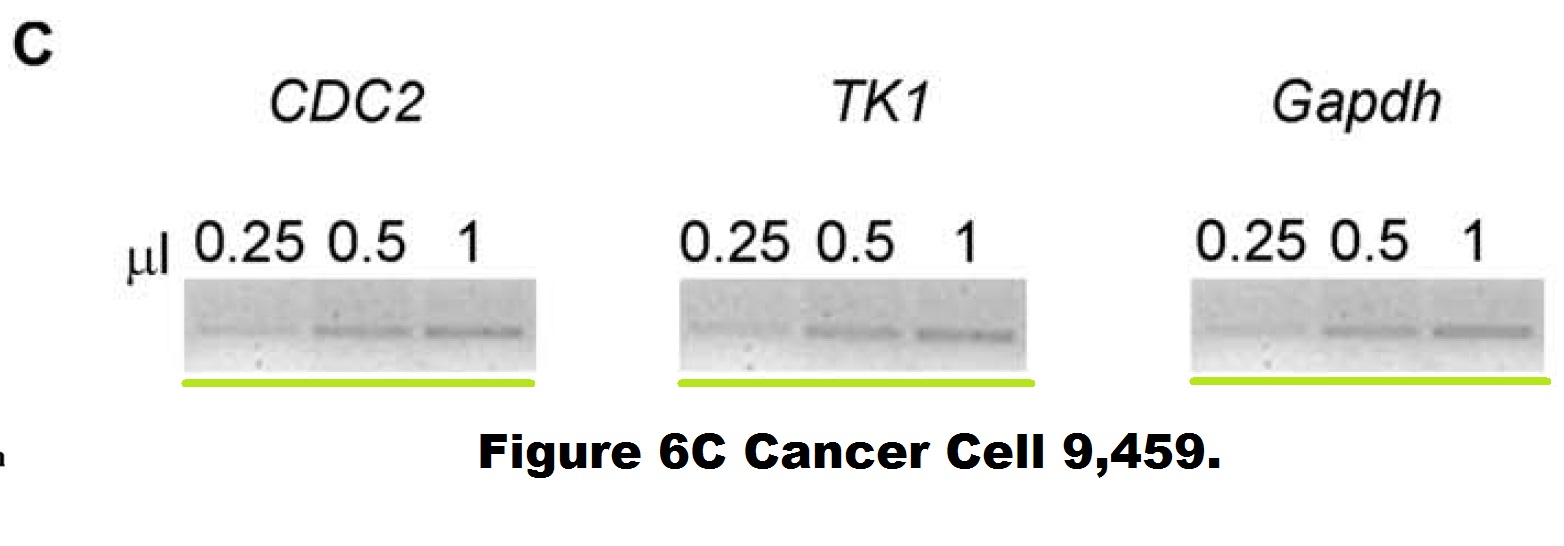
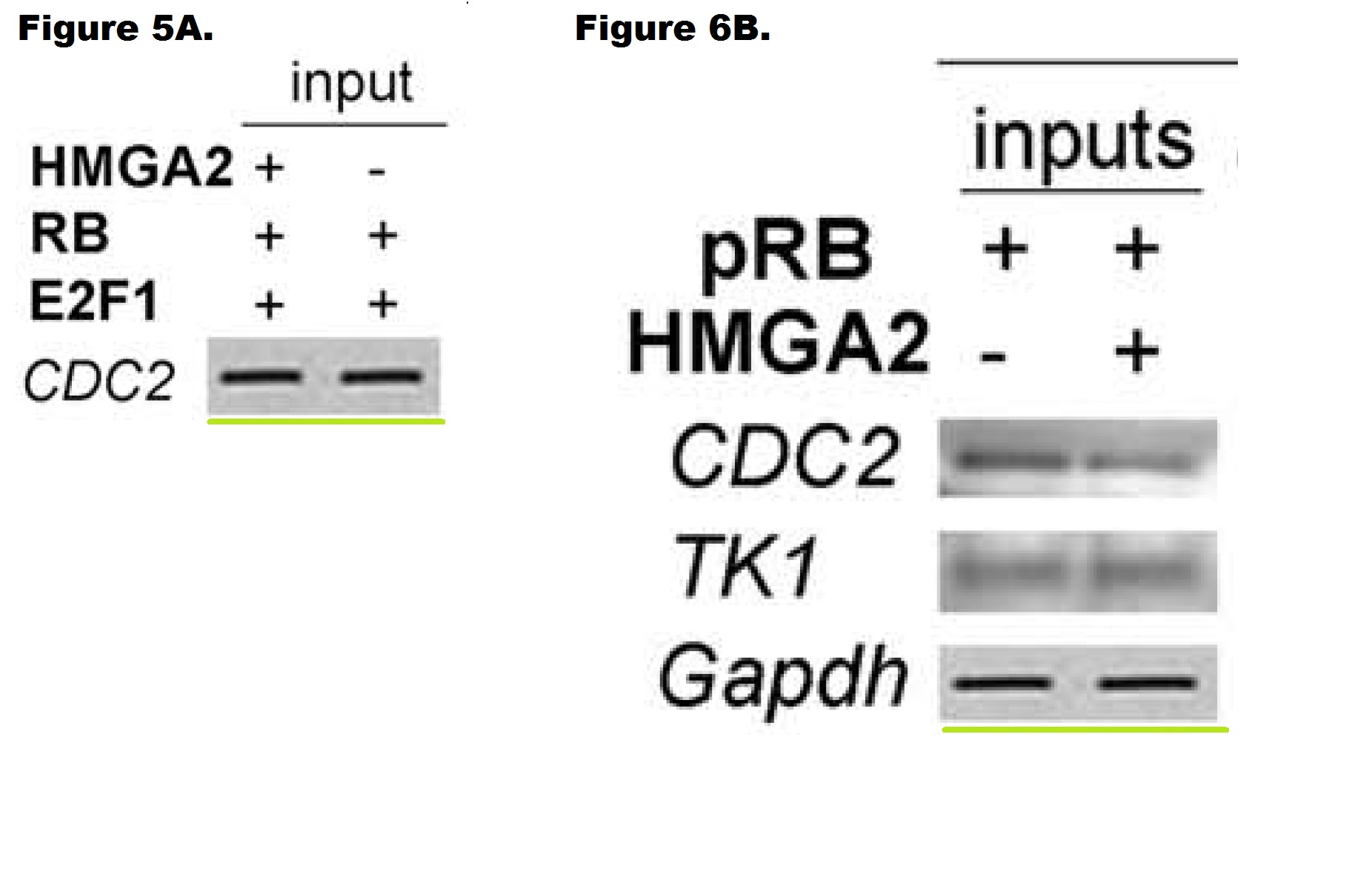

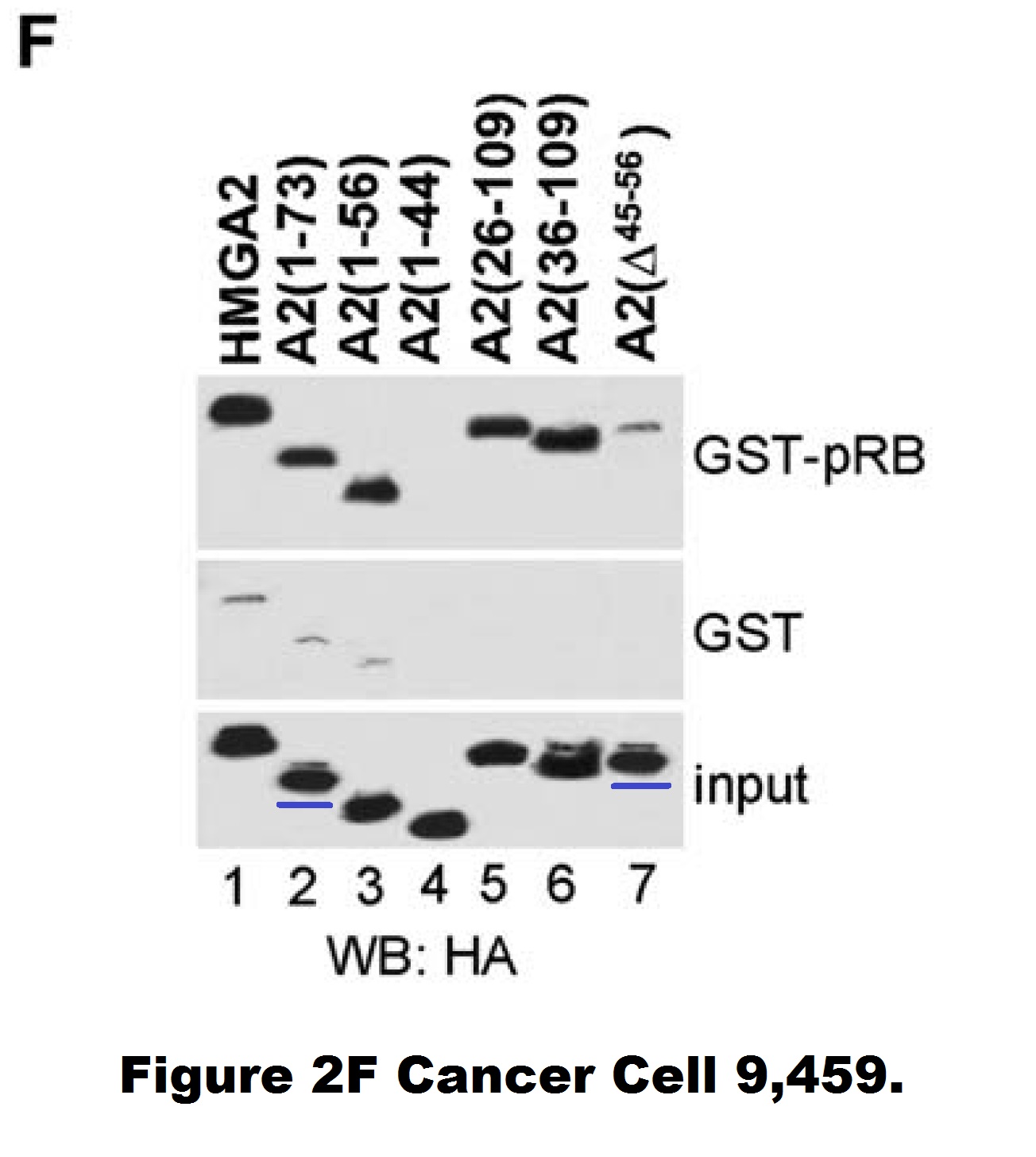
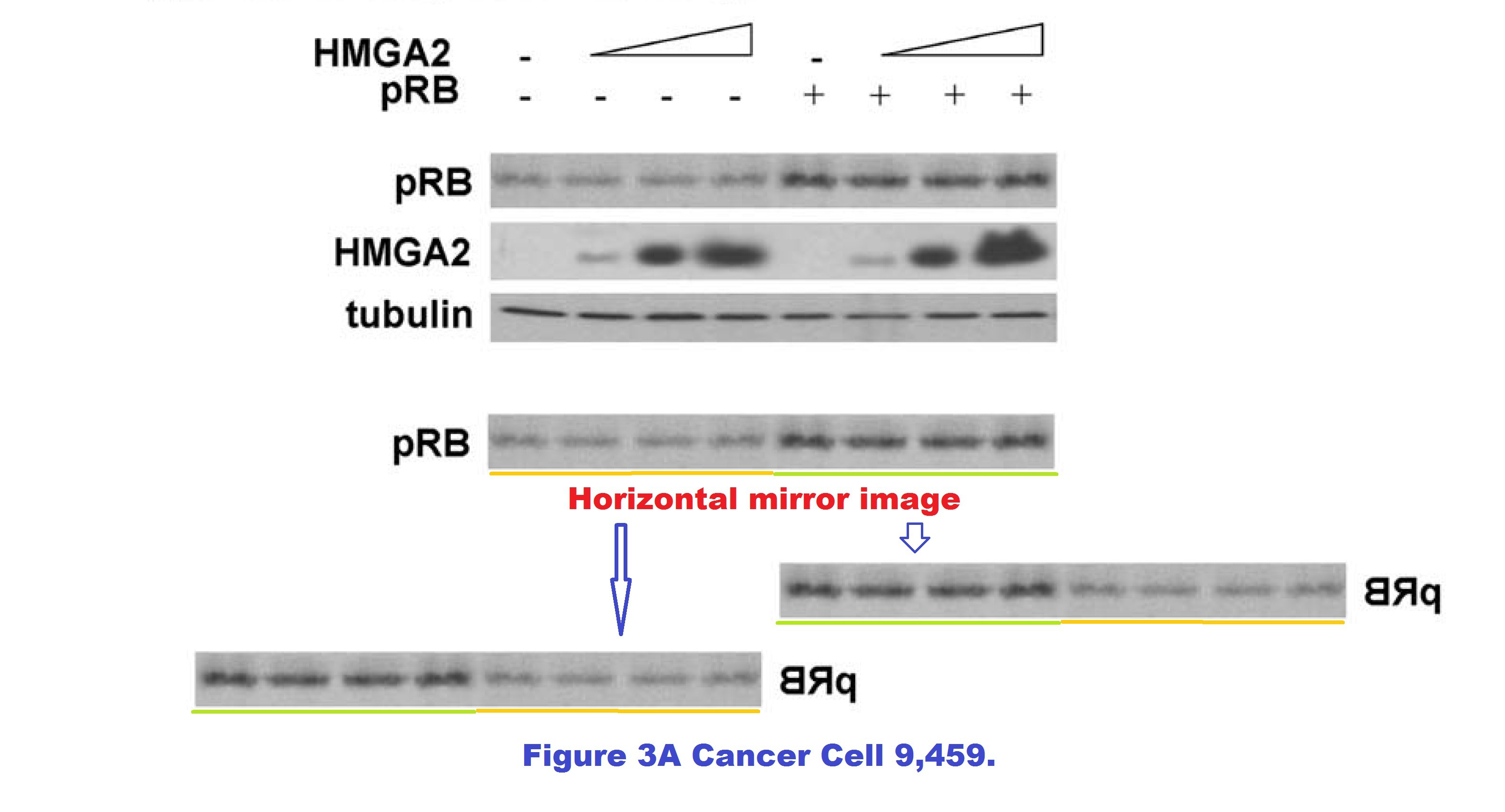
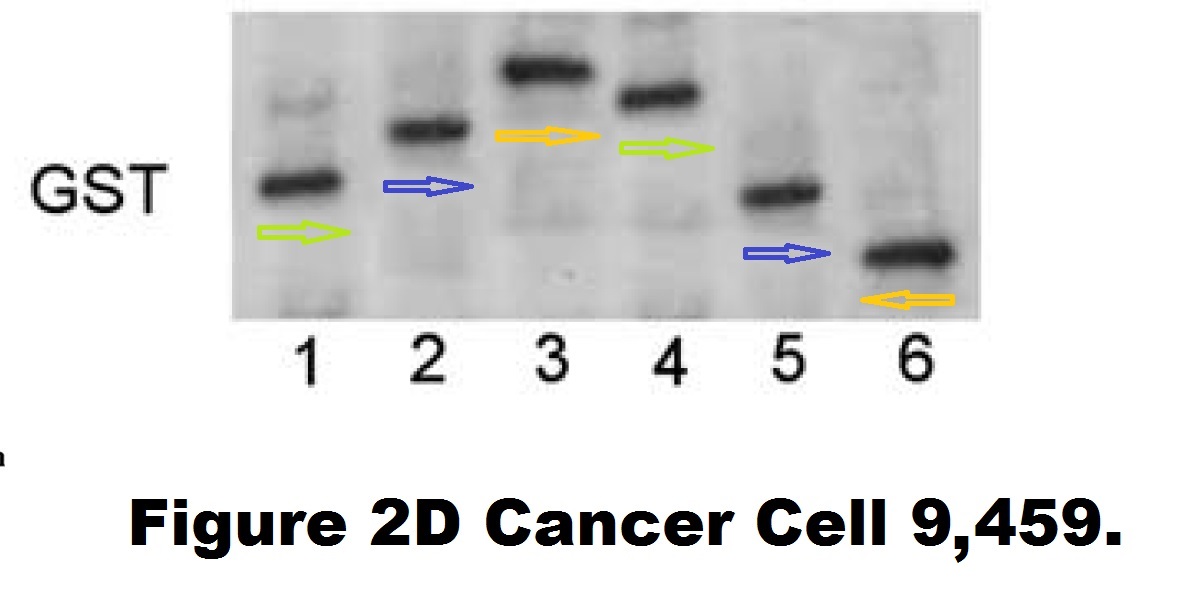

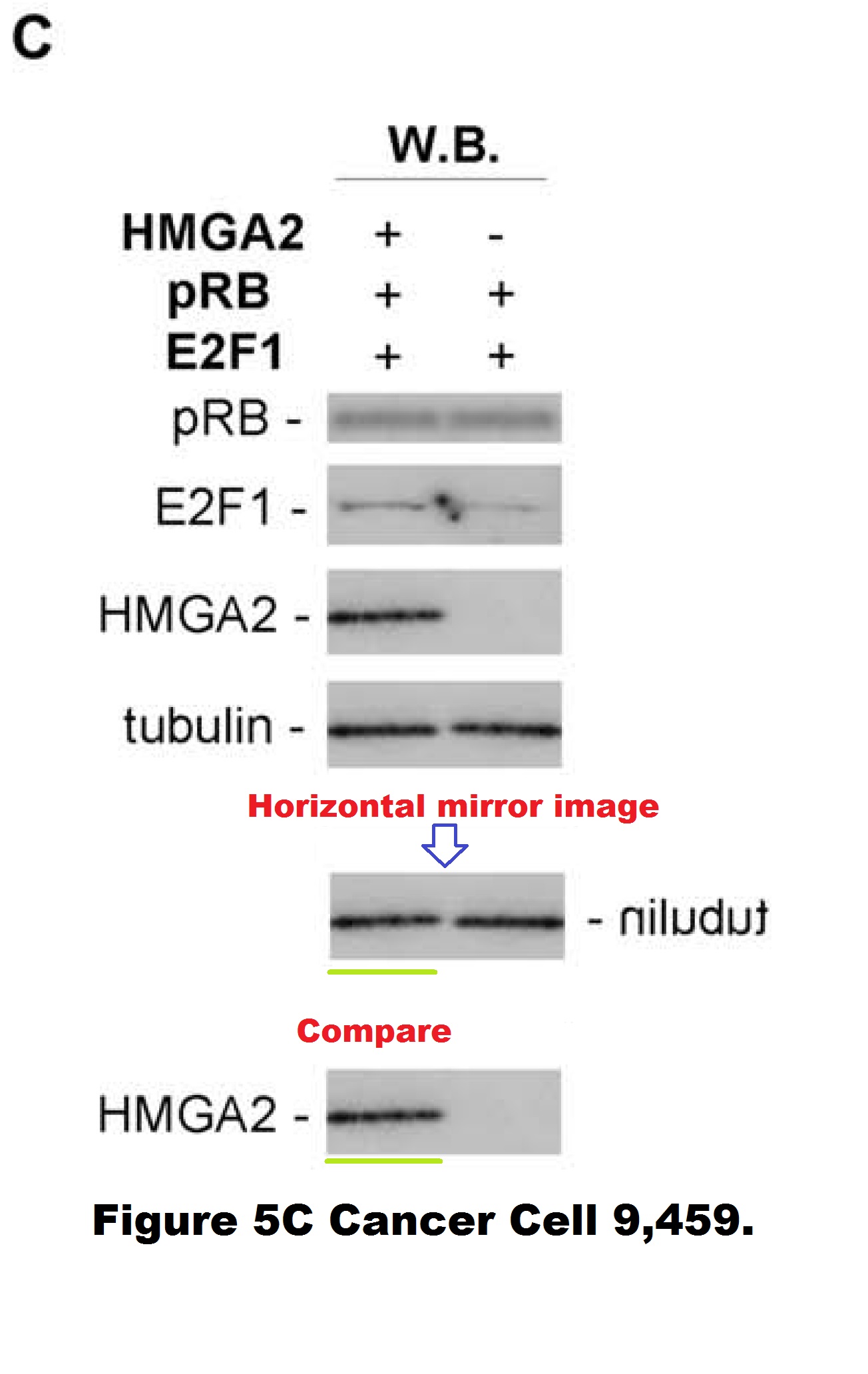
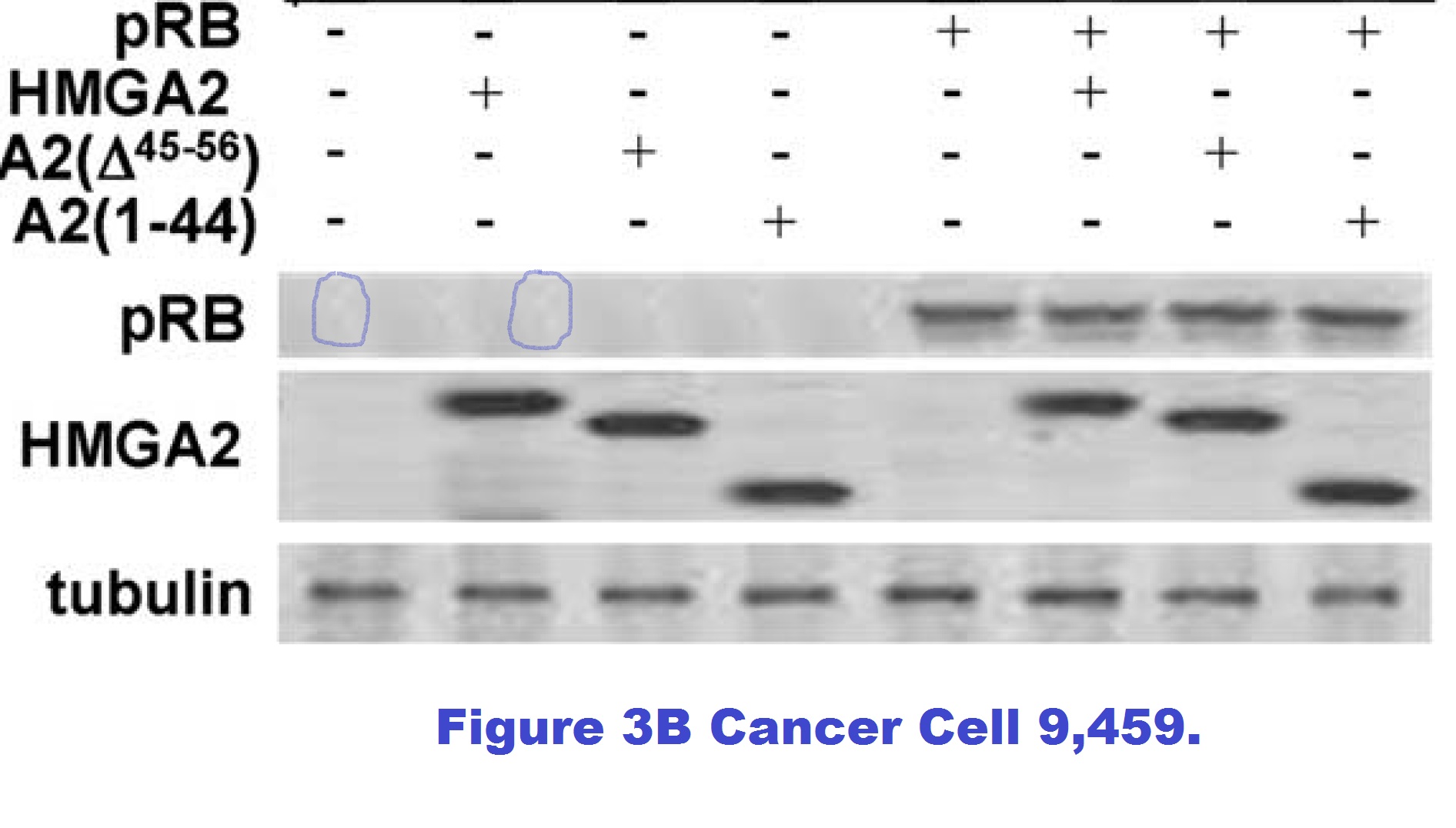
Maybe Helin submitted this PubPeed thread as a cover page to his application to ICR London? In that case, Workman, Ashworth, Lord and other white English men of ICR (all of them fully acquitted of all charges of research misconduct, read here) would have exclaimed: WOW! Never retracted! Not even an editorial note! And look at his collaborators! We found the winner! This man will be the right leader for ICR to continue our proud tradition of fake science while scamming those sad gormless charity pillocks who donate to us their life savings! Look at these donors and our junior scientists, running marathons so we get rich off charitable donations for our Photoshop trouble! Little do they know that should one of them blow the whistle on our research fraud, the dirty little rat will regret having been born!
The men of ICR are namely tough and merciless. The ICR alumnus and professional bully Richard Marais now rules Manchester and the melanoma research field with an iron fist, nobody will ever dare complaining about reproducibility issues. Is Helin also able crack down hard on troublemakers? It seems he can!
But of course tough talk and piggy-backing on Fusco’s and Croce’s fraud is not enough to impress ICR’s charity embezzlement experts. A scientist must always prove his own track record of independent data fudgery to qualify for a leadership position of an English research institution. It is a matter of national pride, the secret of the English science supremacy.

Of course Helin was able to beat the competition there, hands down. His oldest paper criticised on PubPeer is from 1998 (Hataboer et al 1998), already as last author, from the time where many promising young scientists of today were still a spark in some professor’s wandering eye. That, children, was even before Photoshop took hold, back in the days scientists still used glue, scissors and paper to fudge their results.
Most of Helin’s scientific achievements were reported on PubPeer by Clare Francis, recently Cheshire and Aneurus Inconstans joined the treasure hunt. Here an example flagged by Elisabeth Bik:
Cristina Morales Torres, Anne Laugesen, Kristian Helin Utx is required for proper induction of ectoderm and mesoderm during differentiation of embryonic stem cells PLoS ONE (2013) doi: 10.1371/journal.pone.0060020
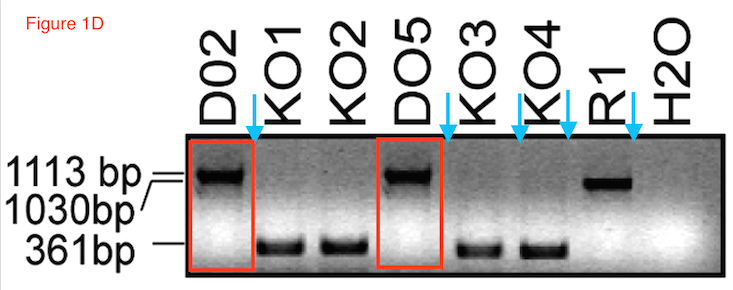
Blue arrows: Some unexpected vertical sharp transitions appear to be visible between lanes“

These forgeries demonstrate the necessary “no f***s given” attitude an ICR leader needs. Helin proved his qualifications to lead the London institute, which main business model is charity scamming via falsified cancer research. I imagine Helin’s job application to have had chapters of “Artwork from Milan” and “Artwork from Copenhagen”. Let’s browse through the impressive files.
Artwork from in Milan
From 1995 till 2007, Helin was group leader at the European Institute of Oncology (IEO) in Milan, Italy. IEO is the one half of the densely packed IFOM-IEO-Campus, its other half being the IFOM institute where I myself worked as postdoc 2008-2012. Thus, I never met Helin, but I know some his coauthors on these papers.
Here a very old one, never corrected, the PubPeer evidence is 7 years old.
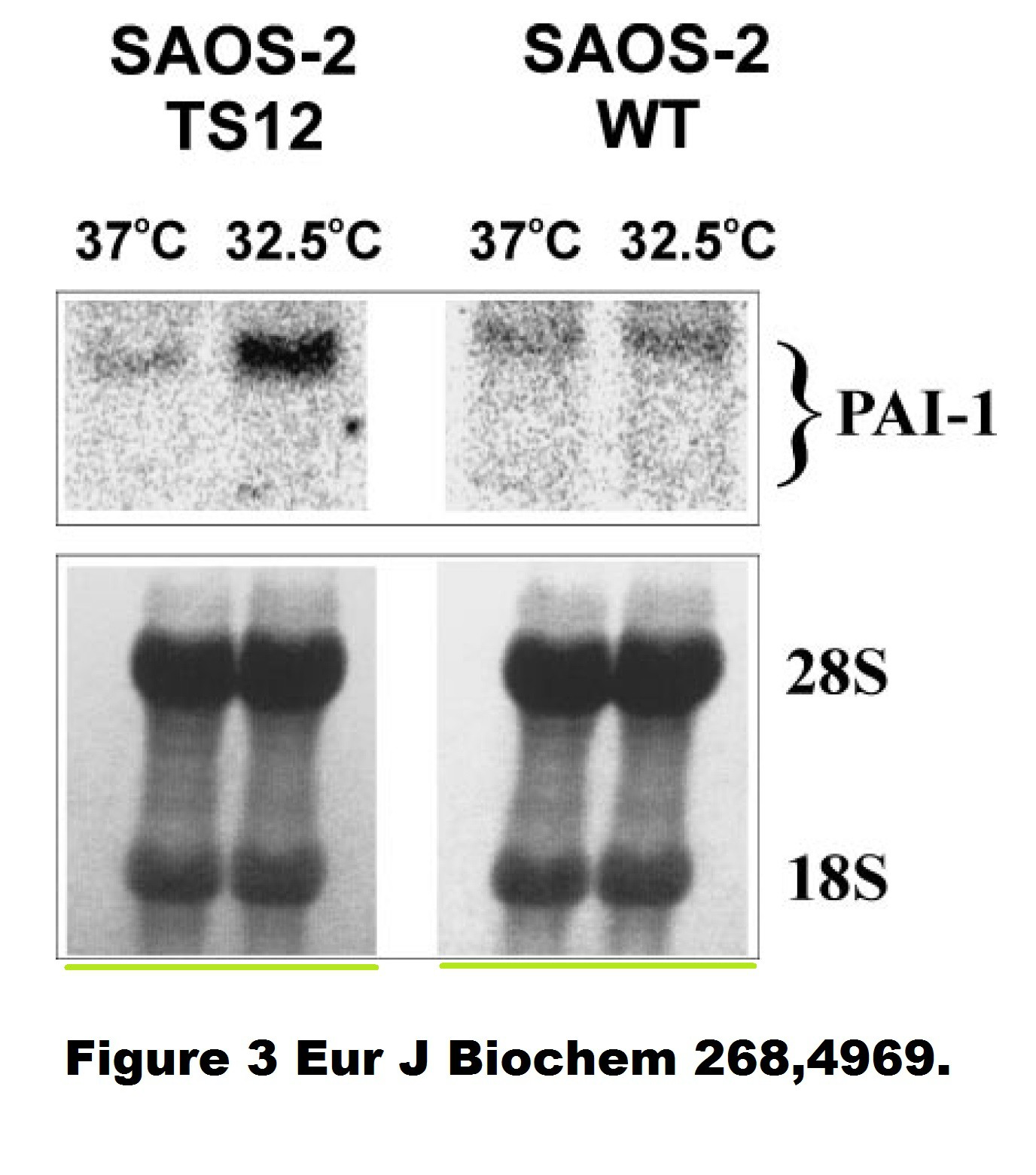
Magdalena Koziczak, Heiko Müller, Kristian Helin, Yoshikuni Nagamine E2F1-mediated transcriptional inhibition of the plasminogen activator inhibitor type 1 gene European Journal of Biochemistry (2001) doi: 10.1046/j.0014-2956.2001.02428.x
You see, the images are differently bright. That’s because they are not copies, but likely different exposures of the same gel, now standing for two different experiments. This next paper from IEO is much worse.
Claire Attwooll, Sergio Oddi, Peter Cartwright, Elena Prosperini, Karl Agger, Peter Steensgaard, Christian Wagener, Claude Sardet, M. Cristina Moroni, Kristian Helin A novel repressive E2F6 complex containing the polycomb group protein, EPC1, that interacts with EZH2 in a proliferation-specific manner Journal of Biological Chemistry (2005) doi: 10.1074/jbc.m412509200

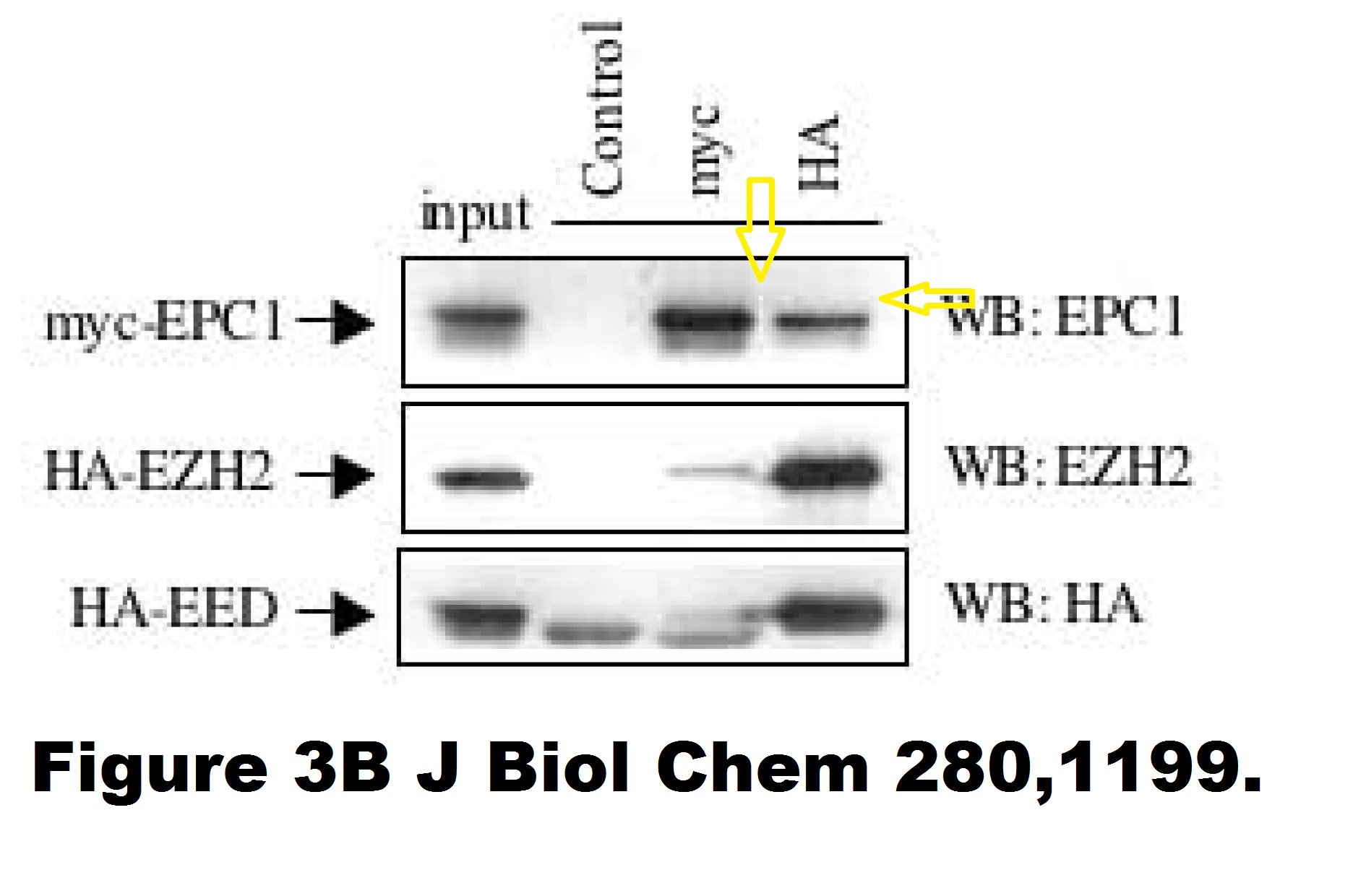
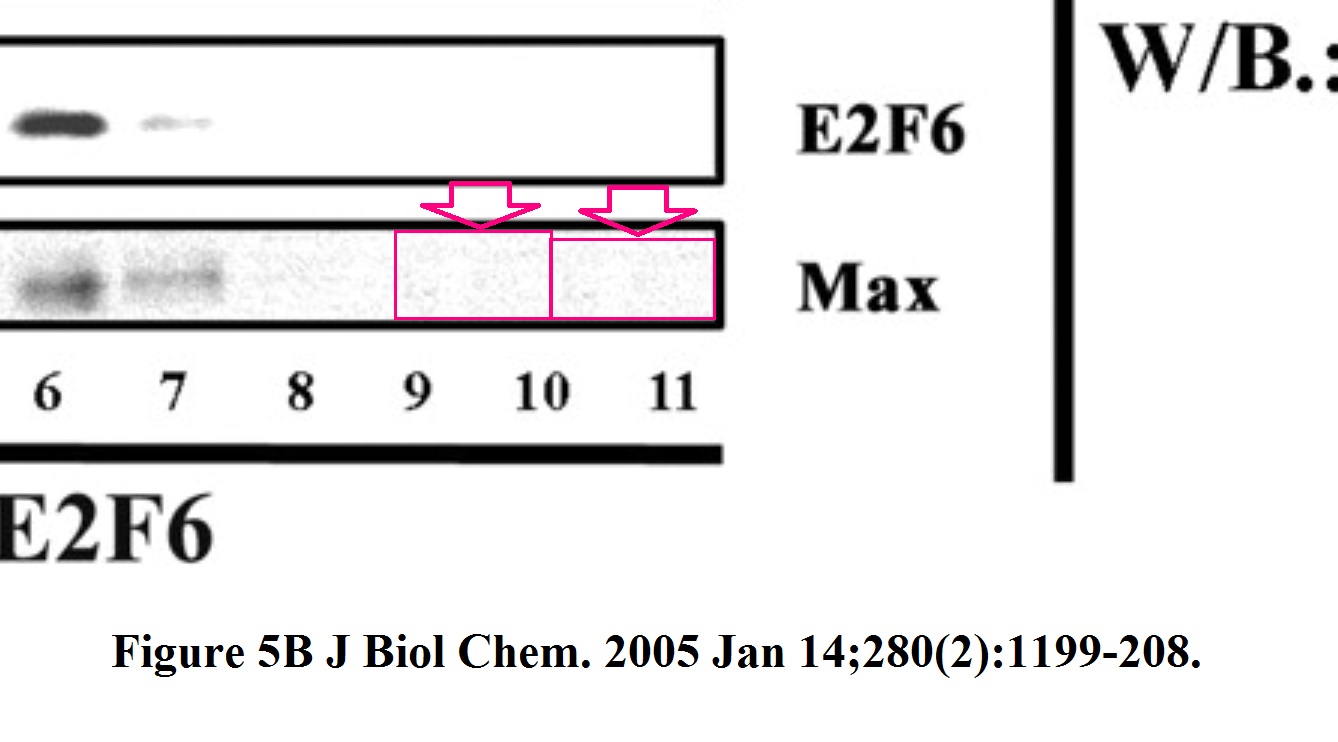
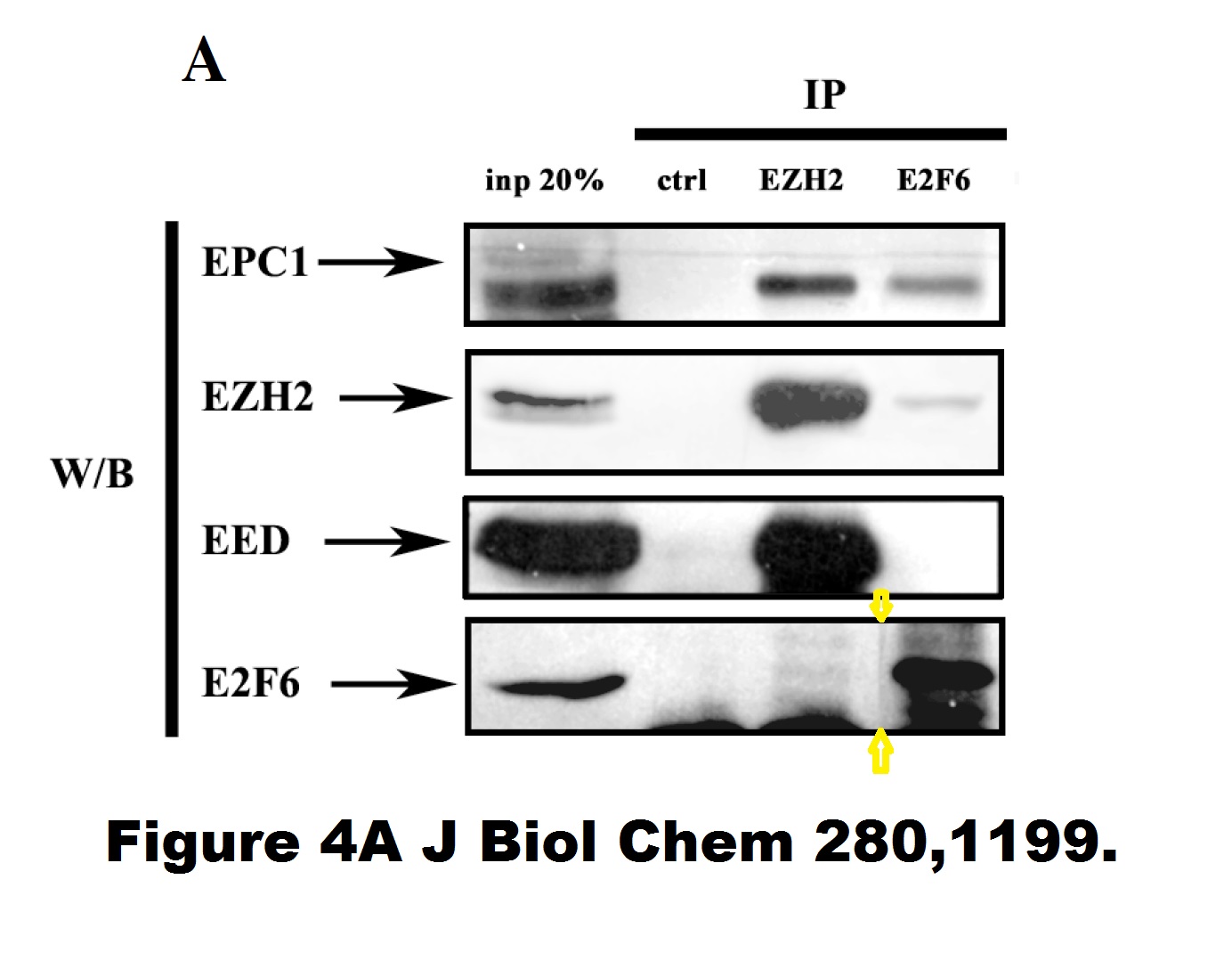
There are more issues in that paper, more spliced and duplicated gel bands. It should be retracted.
I wrote about problematic papers by IFOM-IEO scientists before, and also mentioned Helin and some of his publications, in this article. Several papers were done in collaboration with the IEO leader, and one of Italy’s cancer research dons, Pier Giuseppe Pelicci. I won’t list those papers again here, as you can imagine, there is enough other stuff. Even freshly discovered stuff, like this:
Emanuela Colombo, Paola Bonetti, Eros Lazzerini Denchi, Paola Martinelli, Raffaella Zamponi, Jean-Christophe Marine, Kristian Helin, Brunangelo Falini, Pier Giuseppe Pelicci Nucleophosmin is required for DNA integrity and p19Arf protein stability Molecular and Cellular Biology (2005) doi: 10.1128/mcb.25.20.8874-8886.2005
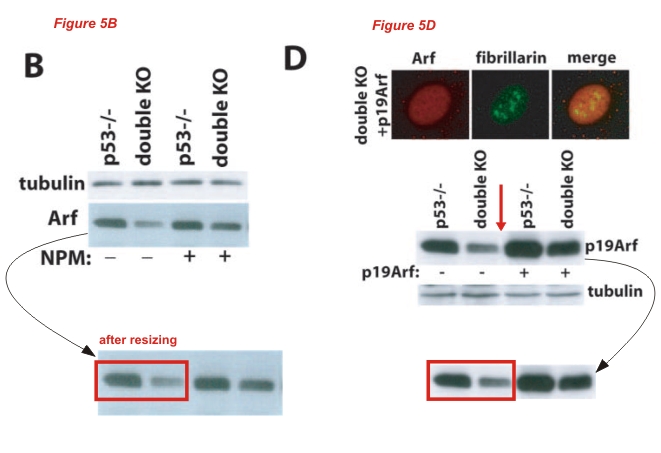
It seems, some bands were re-used, and reappear spliced-on in Fig 5D. The rest of the blot is different. But it’s just controls, right, who needs those anyway? The next paper is very impressive:
Eros Lazzerini Denchi, Kristian Helin E2F1 is crucial for E2F‐dependent apoptosis EMBO reports (2005) doi: 10.1038/sj.embor.7400452
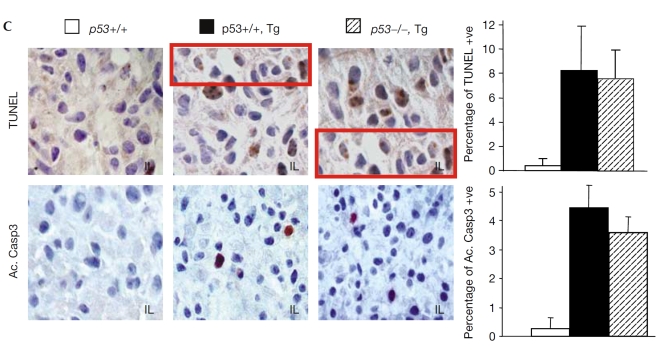

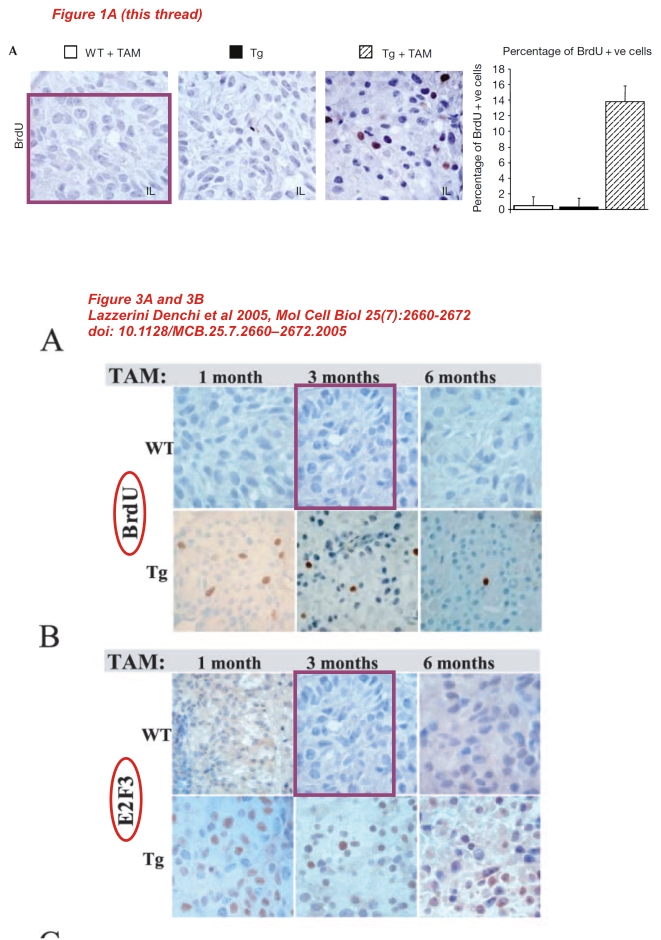
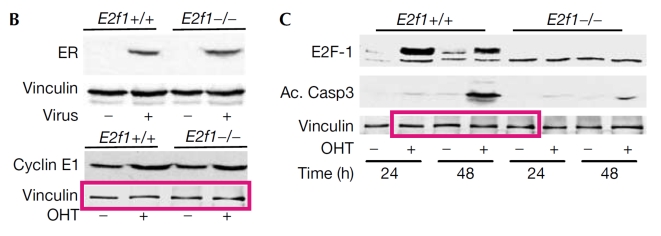
Just two authors, whom to blame here? The first one, Eros Lazzerini Denchi, is now senior investigator at NIH National Cancer Institute (NCI) in Bethesda, Maryland, USA. Another paper of his (Lazzerini Denchi et al Genes & Development 2006), as postdoc with Titia De Lange at Rockefeller University, has similar issues. The Lazzerini Denchi lab at NCI is studying “Genome Integrity” using research dis-integrity he learned as PhD student under Helin in Milan. Like this:

Eros Lazzerini Denchi, Claire Attwooll, Diego Pasini, Kristian Helin Deregulated E2F activity induces hyperplasia and senescence-like features in the mouse pituitary gland Molecular and Cellular Biology (2005) doi: 10.1128/mcb.25.7.2660-2672.2005
The paper contains more recycled images, with adjusted brightness and even flips to avoid detection:
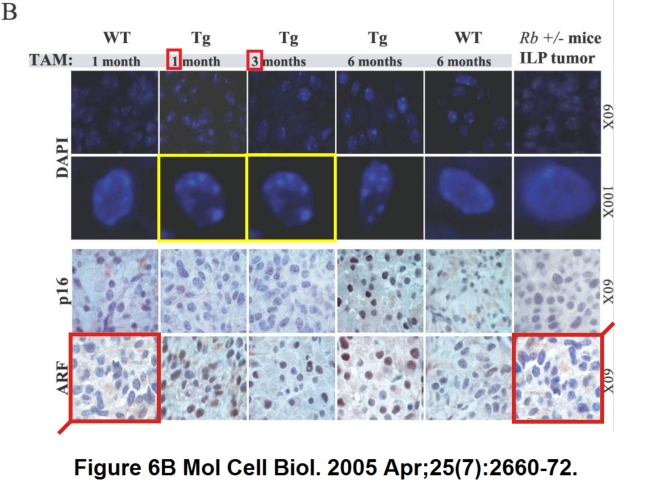
Now, how about some discretely duplicated gel bands? The plan was probably that inside a big gel figure, nobody will notice. But in any case, nobody ever minded, the EMBO J paper was not even corrected:

Adrian P Bracken, Diego Pasini, Maria Capra, Elena Prosperini, Elena Colli, Kristian Helin EZH2 is downstream of the pRB-E2F pathway, essential for proliferation and amplified in cancer The EMBO Journal (2003) doi: 10.1093/emboj/cdg542
FIG 1B, look closely at SUZ12 blot
Of course, Adrian Braken (who now runs his own lab at Trinity College Dublin) and Helin are perfectly able to clone more than just one gel band.
Adrian P Bracken, Daniela Kleine-Kohlbrecher, Nikolaj Dietrich, Diego Pasini, Gaetano Gargiulo, Chantal Beekman, Kim Theilgaard-Mönch, Saverio Minucci, B. T. Porse, Jean-Christophe Marine, Klaus H Hansen, Kristian Helin The Polycomb group proteins bind throughout the INK4A-ARF locus and are disassociated in senescent cells Genes & Development (2007) doi: 10.1101/gad.415507
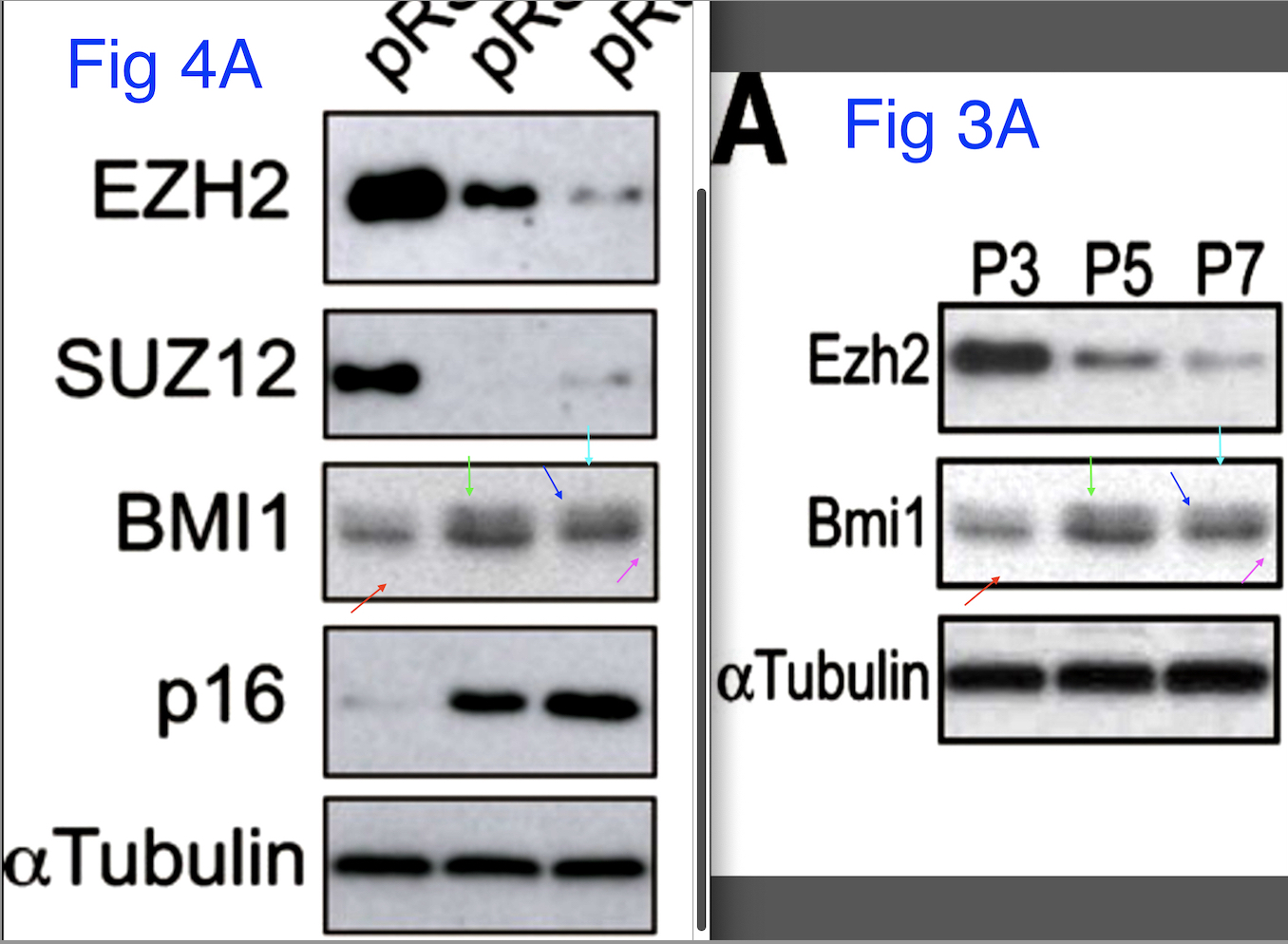
This collaborative study is impressively fraudulent:
Lovorka Stojic, Zuzana Jasencakova, Carolina Prezioso, Alexandra Stützer, Beatrice Bodega, Diego Pasini, Rebecca Klingberg, Chiara Mozzetta, Raphael Margueron, Pier Lorenzo Puri, Dirk Schwarzer, Kristian Helin, Wolfgang Fischle, Valerio Orlando Chromatin regulated interchange between polycomb repressive complex 2 (PRC2)-Ezh2 and PRC2-Ezh1 complexes controls myogenin activation in skeletal muscle cells Epigenetics & chromatin (2011) doi: 10.1186/1756-8935-4-16

Can you see what was done to Figure 6B? Undesired gel bands were covered up with grey boxes, probably in Microsoft PowerPoint. This is such blatant research fraud that the only consequence here is…., oh well, never mind, do nothing and give all authors several huge grants and a promotion. Because the conclusion, namely that cancer research and regenerative medicine are all about defrauding the public and bullshitting desperate patients, are definitely not affected here. Here another collaboration, but better handiwork:
Masamitsu Negishi, Atsunori Saraya, Shinobu Mochizuki, Kristian Helin, Haruhiko Koseki, Atsushi Iwama A novel zinc finger protein Zfp277 mediates transcriptional repression of the Ink4a/arf locus through polycomb repressive complex 1 PLoS ONE (2010) doi: 10.1371/journal.pone.0012373
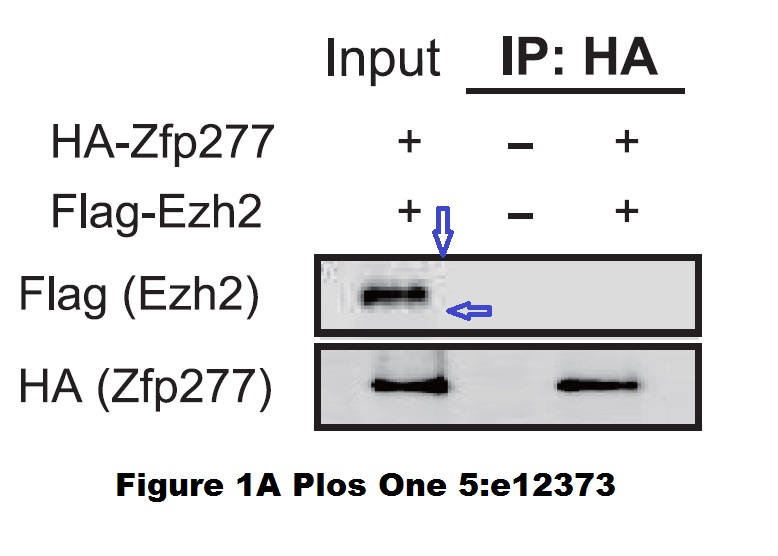
The highlighted band in Fig 1A was digitally stitched on. The 4-lane Jmjd3 blot in Fig 3B is a composite (arrow), and so is possibly Ezh2, other blots may have anything between 4 or 5 lanes, while the 5-lane tubulin blot in that figure doesn’t really fit, its middle lane seems to be covered up by a blank field.
The following IEO paper features the team of two Czech scientists, Jiri Lukas and Jiri Bartek (both back then in Copenhagen, Denmark, Bartek is now at Karolinska Institutet in Stockholm, Sweden), whom I once met when interviewing for an EMBO fellowship (which I got). It is a pity Lukas and Bartek could not convince Helin to correct or better to retract that paper. It is namely worse than initially thought, when some undisclosed splicing was flagged 7 years ago.
Marina Melixetian, Andrea Ballabeni, Laura Masiero, Patrizia Gasparini, Raffaella Zamponi, Jiri Bartek, Jiri Lukas, Kristian Helin Loss of Geminin induces rereplication in the presence of functional p53 The Journal of Cell Biology (2004) doi: 10.1083/jcb.200403106
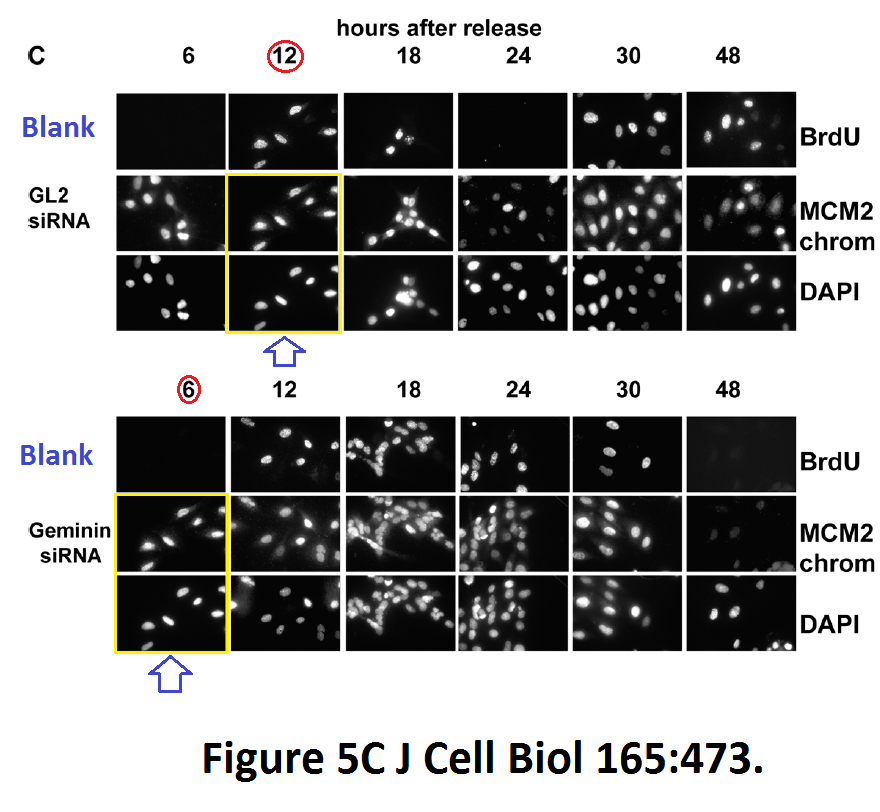
This copy-pasted flaw cytometry in Figures 2B and 5A was flagged by Clare Francis very recently, and hints that the paper may be utterly unreliable.
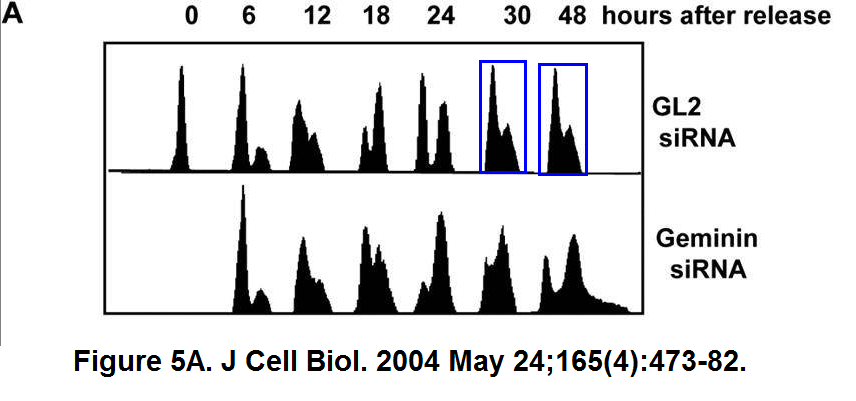
If you enjoyed cloned FACS plots, here a Helin classic, with some recurrent names you will recognise:
B O Petersen, C Wagener, F Marinoni, E R Kramer, M Melixetian, E Lazzerini Denchi, C Gieffers, C Matteucci, J M Peters, K Helin Cell cycle- and cell growth-regulated proteolysis of mammalian CDC6 is dependent on APC-CDH1 Genes Dev. (2000) doi: 10.1101/gad.832500.

Artwork from Copenhagen
In around 2006, the native Dane Helin moved to Copenhagen, where he eventually became director of BRIC, the Copenhagen cancer research institute, which now hosts another Photoshop artist, Janine Erler. Helin was also interim Vice Dean for Research at the University of Copehagen, thus in charge of all research integrity in the town. In this capacity and as BRIC director, Helin was personally accused of silencing whistleblowers in the Erler affair, and even of being involved in the massive-scale destruction of the whistleblowers’ research material.
This is what Helin himself produced back at that period:
Marina Melixetian, Ditte Kjaersgaard Klein, Claus Storgaard Sørensen, Kristian Helin NEK11 regulates CDC25A degradation and the IR-induced G2/M checkpoint Nature Cell Biology (2009) doi: 10.1038/ncb1969

Here a lazy one:
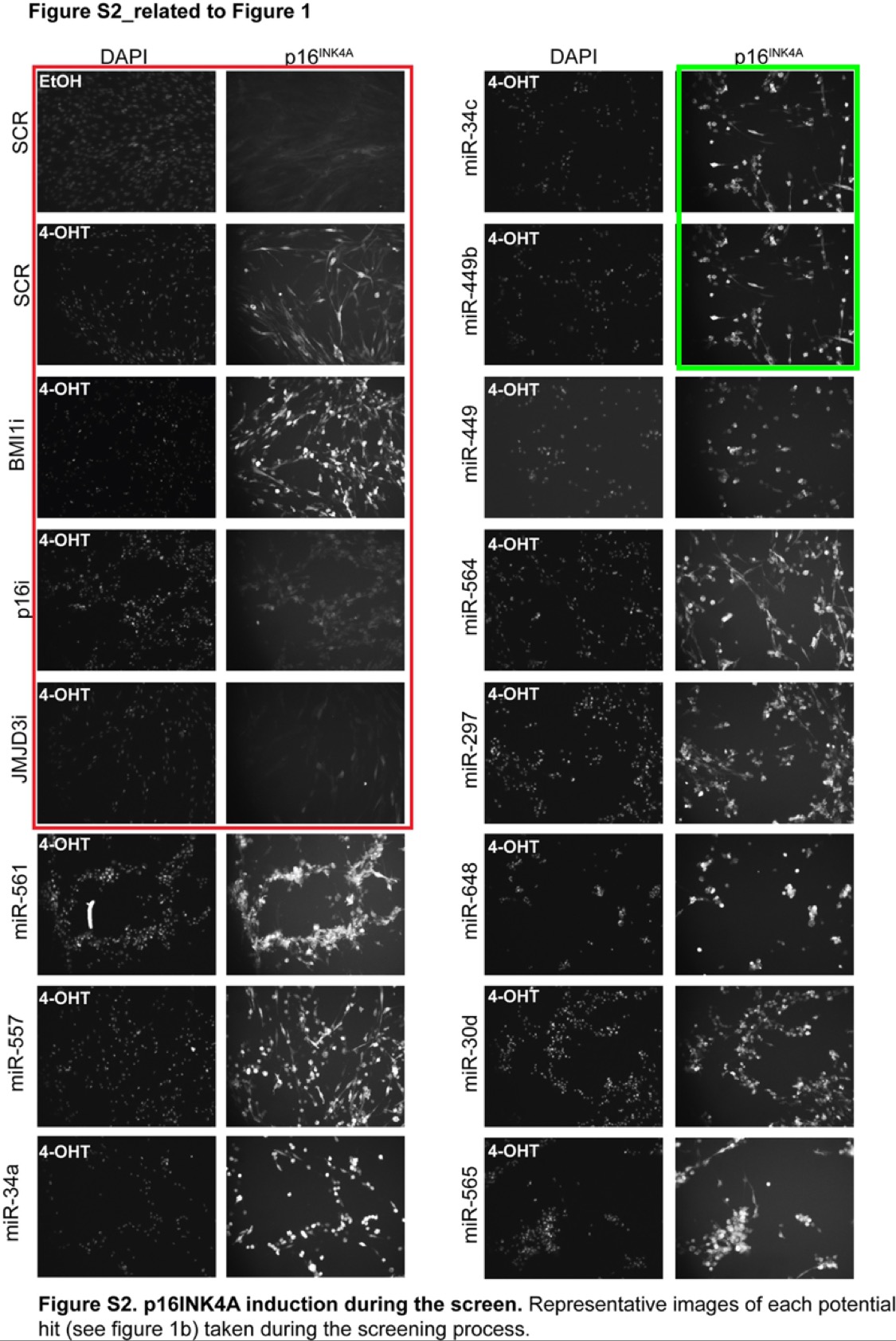
Susanne Marije Kooistra, Lise Christine Rudkjær Nørgaard, Michael James Lees, Cornelia Steinhauer, Jens Vilstrup Johansen, Kristian Helin A screen identifies the oncogenic micro-RNA miR-378a-5p as a negative regulator of oncogene-induced senescence PLoS ONE (2014) doi: 10.1371/journal.pone.0091034
“Figure S2 appears to have a repeated image (green box). Red box in original.”
Another lazy approach to generating scientific results:
Diego Pasini, Martina Malatesta, Hye Ryung Jung, Julian Walfridsson, Anton Willer, Linda Olsson, Julie Skotte, Anton Wutz, Bo Porse, Ole Nørregaard Jensen, Kristian Helin Characterization of an antagonistic switch between histone H3 lysine 27 methylation and acetylation in the transcriptional regulation of Polycomb group target genes Nucleic Acids Research (2010) doi: 10.1093/nar/gkq244
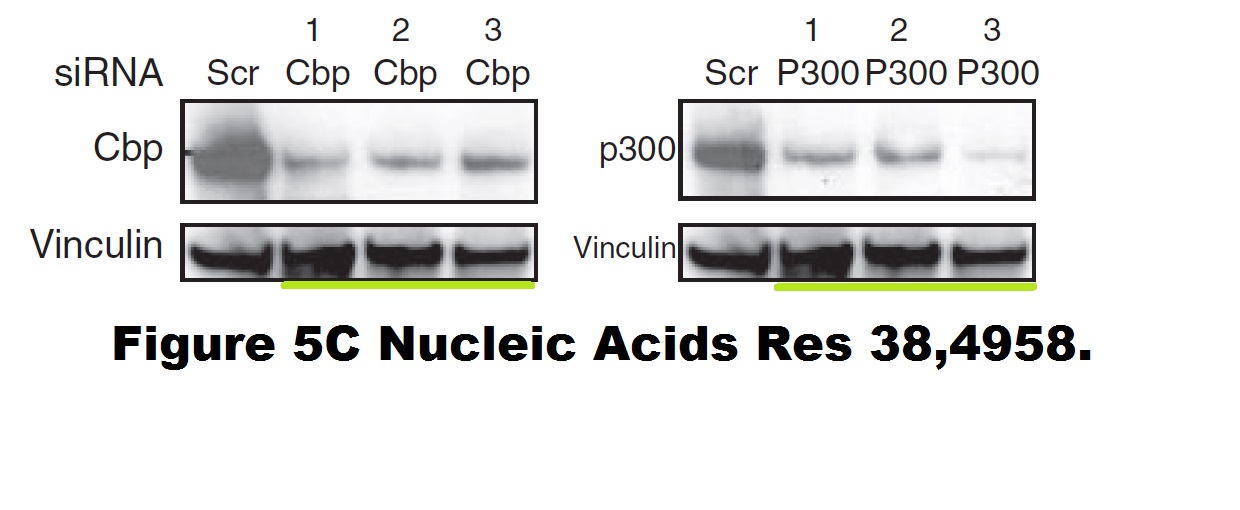
Diego Pasini, who inherited Helin’s lab in IEO, Milan, and first author on this and co-author on several other problematic papers replied on PubPeer 7 years ago:
“We must have copied by mistake one of the panels during figure editing.“
There was no correction ever since.
In 2018, BRIC decided to appoint a new director, and Helin announced to concentrate on his new job at MSKCC in New York, though he retained his professorship in Copenhagen. Now he goes back to Europe, to the Brexited England, liberated from all petty laws and regulations. Helin’s appointment can only become a success, he will lead a crack team of bum-lickers and cheaters.
Helin did not reply to my email asking for comment about his PubPeer record. ICR London announced to reply, silence so far.

Donate!
If you are interested to support my work, you can leave here a small tip of $5. Or several of small tips, just increase the amount as you like (2x=€10; 5x=€25). Or would you rather donate to ICR London?
€5.00

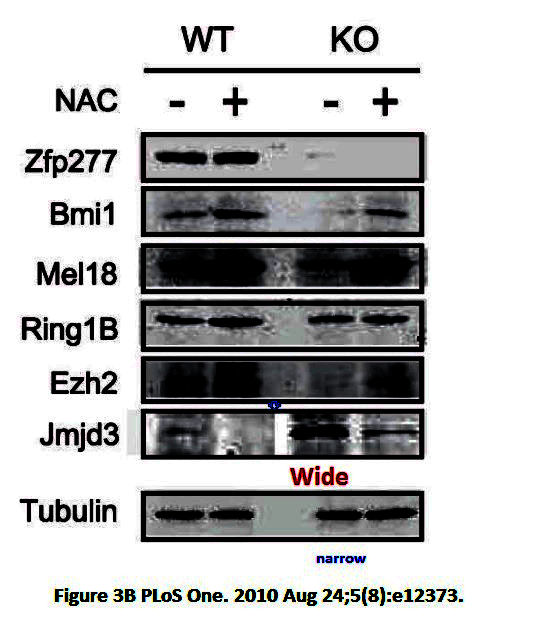


Seriously, while I appreciate the hat tip, my contributions are minor and I am only following in the footsteps of more substantial contributors. But if you keep up all the compliments, I will have to increase my monthly contribution. 🖤
LikeLiked by 1 person
I thought about mentioning Kristian Helin’s data to Joan Massague, the director of the Sloan Kettering Institute, where Helin is presently part of the leadership himself.
.
https://www.mskcc.org/research/ski/about/leadership
https://www.mskcc.org/research/ski/about/director-joan-massague
Then I had second thoughts. An invasion of the body snatchers moment.
https://pubpeer.com/publications/BFF9F09E15DDB01ECE4BE1BE29EBCC
Figure 2C.
https://pubpeer.com/publications/8507E12CC66CA1F853B1F05F139BFB
Figure 2c.
https://pubpeer.com/publications/E81EF46BAE14A6C9A87C70A0488A9F
Figure 1.
LikeLike
IEO has a Research Integrity committee.
https://www.research.ieo.it/about-us/governance/management-committees/research-integrity-committee/
For some reason, among its members is Myriam Alcalay, a IEO group leader.
Myriam Alcalay, Natalia Meani, Vania Gelmetti, Anna Fantozzi , Marta Fagioli , Annette Orleth , Daniela Riganelli, Carla Sebastiani, Enrico Cappelli, Cristina Casciari , Maria Teresa Sciurpi, Angela Rosa Mariano, Simone Paolo Minardi, Lucilla Luzi, Heiko Muller , Pier Paolo Di Fiore, Guido Frosina, Pier Giuseppe Pelicci Acute myeloid leukemia fusion proteins deregulate genes involved in stem cell maintenance and DNA repair Journal of Clinical Investigation (2003) doi: 10.1172/jci17595
LikeLike
Pingback: Transparently ridiculous – ocasapiens
“This man will be the right leader for ICR to continue our proud tradition of fake science while scamming those sad gormless charity pillocks who donate to us their life savings!”
I feel sorry for the chuggers. Sometimes they do it out of the best of intentions.
About a year ago I came across a group of chuggers on behalf of ICR at Victoria Station.
I asked them why they did it. One young man said that his mother had died of breast cancer.
When I showed him Paul Workman’s data on Pubpeer he said that there did seem to be a lack of quality control.
chugger
[ˈtʃʌɡə]
NOUN
chuggers (plural noun)
a person who approaches passers-by in the street asking for subscriptions or donations to a particular charity.
“when you have chuggers outside your shop, people just cross the road”
LikeLike
Natural selection applies to “scientists”. Odd that people took such a long time to recognise that.
Triage for brazen bullshitters and smarmy gits.
LikeLike
More “Artwork from in Milan”.
“European Institute of Oncology (IEO) in Milan, Italy.”
Cell. 2005 Jul 29;122(2):221-33. doi: 10.1016/j.cell.2005.05.011.
Electron transfer between cytochrome c and p66Shc generates reactive oxygen species that trigger mitochondrial apoptosis
Marco Giorgio 1, Enrica Migliaccio, Francesca Orsini, Demis Paolucci, Maurizio Moroni, Cristina Contursi, Giovanni Pelliccia, Lucilla Luzi, Saverio Minucci, Massimo Marcaccio, Paolo Pinton, Rosario Rizzuto, Paolo Bernardi, Francesco Paolucci, Pier Giuseppe Pelicci
Affiliation1
Experimental Oncology Department, European Institute of Oncology, Milan, Italy.
marco.giorgio@ifom-ieo-campus.it
PMID: 16051147 DOI: 10.1016/j.cell.2005.05.011
Problematic data figure 6D. Much more similar than expected.
LikeLike
Looks like Krisitan Helin “went native”.
LikeLike
“Both its previous presidents, Alan Ashworth and Paul Workman, have impressive records of data fakery on PubPeer.”
https://forbetterscience.com/2018/09/06/fake-data-untouchable-men-and-guilty-women-at-icr-london/
” Chris Lord and Alan Ashworth. The latter became ICR president in January 2011, and after a brief tenure of mere 3.5 years Ashworth moved in 2014 to San Francisco, California, to head the Helen Diller Family Comprehensive Cancer Center, as Senior Vice President for Cancer Services at UCSF.2
Will Sir Keir Starmer (Alan Ashworth) take full responsibility, or blame Angela Rayner (Sarah Martin)?https://www.youtube.com/watch?v=xH62YUhXlpA
Alan Ashworth:
https://pubpeer.com/publications/42FF13924A832C7D4375AB8E29CB10
https://pubpeer.com/publications/0BA7677DD5145F7BDAAC5046FBA227
https://pubpeer.com/publications/22A0D80CF891EEFEB7C23332484780
https://pubpeer.com/publications/CECD3E767BD0AFA9DDB1BA919F663F
https://pubpeer.com/publications/261D475F6640FC59C9A867EC7F5DD2
https://pubpeer.com/publications/829CAA6543206167CC6803CE33FE2E
https://pubpeer.com/publications/509134CE1EE1E6A1C7DEA161CB77CB#4
https://pubpeer.com/publications/5DAB0ED87363E34C2A41ADEB994143#2
https://pubpeer.com/publications/67F39E13B7C8B51E8F8F34D70AFF84
https://pubpeer.com/publications/C2570E46E89E6746B01CF962D728A8#3
https://pubpeer.com/publications/40975CCD671ACC13843AC53551942C#2
Sarah Martin (without Alan Ashworth):
https://pubpeer.com/publications/2759A34758691741B87D49DFB05C3E
https://pubpeer.com/publications/8E38ECD6759C2479400E4306A749EB
https://pubpeer.com/publications/C961F8BD02A1C6B26EDD0358BEE8FC
Sarah Martin with Alan Ashworth:
https://pubpeer.com/publications/22A0D80CF891EEFEB7C23332484780
https://pubpeer.com/publications/CECD3E767BD0AFA9DDB1BA919F663F
https://pubpeer.com/publications/261D475F6640FC59C9A867EC7F5DD2
https://pubpeer.com/publications/67F39E13B7C8B51E8F8F34D70AFF84
LikeLike
“Which amazing Photoshop artists did the Great Dane Helin beat at the end?”
The Great Dane is Victor Borge. Kristian Helin is in a different league.
LikeLike
ICR London is the Centre de Recherche des Cordeliers of the U.K.,
http://www.crc.jussieu.fr/guido_kroemer2.html
https://forbetterscience.com/2018/10/18/lopez-otin-and-kroemer-birds-of-a-feather-flock-together/
not the Pasteur Institute of the U.K..
https://forbetterscience.com/2019/11/11/academic-throne-succession-from-anne-dejean-to-oliver-bischof/
see the 25.05.2021 update.
LikeLike
https://www.icr.ac.uk/news-archive/icr-announces-new-chair-of-board-of-trustees
For such a prominent personage the full press release needs to be seen.
“ICR announces new Chair of Board of Trustees
Professor Julia Buckingham CBE, an acclaimed medical researcher with exceptional leadership experience in academic institutions and across the sector, will become Chair of The Institute of Cancer Research, London, in August.
Professor Buckingham is one of the highest-profile figures in the UK higher education sector, with current positions as President of Universities UK and Vice-Chancellor and President of Brunel University London.
Her appointment as Chair of the Board of Trustees will enable the ICR to build on its status as a world-leading cancer research institute by strengthening its position within the UK’s academic research and higher education sectors.
Professor Buckingham will take over as Chair on 1 August from businessman and entrepreneur Luke Johnson, who runs private equity firm Risk Capital Partners. Luke Johnson has led the ICR’s board for two successful four-year terms.
Passionate advocate for research and workplace culture
Professor Buckingham has devoted her career to leadership at the interface between scientific research and education. She is passionate about creating the best possible workplace culture at research institutions – ensuring the environment for staff and students is stimulating, inspiring, inclusive and supportive.
She has held positions including as Chair of the Concordat Strategy Group, which aims to enhance the research environment and open up opportunities for professional development, and Chair of the Athena SWAN Review Steering Group, which oversees moves towards greater gender equality in research.
Professor Buckingham has published widely in her field of pharmacology and received numerous awards and honours for her work, including a CBE in 2018 for services to biology and education, and election as a Fellow of the Academy of Medical Sciences in 2019.
A sector leader
She will complete her two-year term as President of Universities UK on 31 July 2021 and is currently in the process of handing over leadership at Brunel, with her departure date yet to be confirmed.
In April, the ICR announced the appointment of a new Chief Executive, Professor Kristian Helin, who will be joining the ICR on 1 September 2021 from Memorial Sloan Kettering Cancer Center in the US. He succeeds Professor Paul Workman who has led the ICR with distinction since 2014.
Professor Buckingham will support the ICR’s new CEO in making the transition to the UK research environment, following his previous leadership roles in Denmark, Italy and the US. Her extensive experience as a sector leader will be invaluable in helping to ensure robust governance and leadership at the top of the ICR – as well as in enabling the organisation to navigate the wider political and funding landscape.
Contributing to the ICR’s mission
Charlie Geffen, Deputy Chair of The Institute of Cancer Research, London, who led the recruitment of the new Chair, said: “We are all delighted that Julia has agreed to become Chair at the ICR. Not only is she a highly effective senior academic leader but she is also a passionate advocate for research and workplace culture. She will provide invaluable support to the incoming Chief Executive and be an influential advocate for our institution.
“I would also like to thank Luke Johnson who has successfully led the ICR over the past eight years. He has fostered an entrepreneurial spirit which is reflected in the record levels of income that have been ploughed back into life-saving research during his tenure. The ICR has learned a great deal from him and as a result is in a stronger position to face the challenges ahead.”
Professor Julia Buckingham, Incoming Chair of The Institute of Cancer Research, London, said: “It’s an honour to take on this important role at such a distinguished scientific institution, which has contributed so much to driving forward cancer research and benefiting patients in the UK and around the world.
“I am excited by the opportunity to contribute to the ICR’s mission to make the discoveries that defeat cancer, and I look forward to working closely with the incoming Chief Executive and his leadership team. I hope I can help the ICR navigate the wider academic landscape, and also intend to bring my passions to bear in ensuring the workplace culture does everything it can to support staff and students to thrive in their roles.” ”
Highly problematic data Endocrinology. 2003 Apr;144(4):1164-74.
Endocrinology. 2003 Apr;144(4):1164-74. doi: 10.1210/en.2002-220592.
Dexamethasone induces rapid serine-phosphorylation and membrane translocation of annexin 1 in a human folliculostellate cell line via a novel nongenomic mechanism involving the glucocorticoid receptor, protein kinase C, phosphatidylinositol 3-kinase, and mitogen-activated protein kinase
Egle Solito 1, Abeda Mulla, John F Morris, Helen C Christian, Roderick J Flower, Julia C Buckingham
Affiliation
1
Department of Neuroendocrinology, Division of Neuroscience and Psychological Medicine, Faculty of Medicine, Imperial College London, Hammersmith Hospital Campus, London W12 ONN, United Kingdom. e.solito@imperial.ac.uk
PMID: 12639897 DOI: 10.1210/en.2002-220592
Problematic data figures 4 and 5. Much more similar and different than expected after horizontal flipping and vertical stretching, by the way different treatments.
Senior author presently: https://www.brunel.ac.uk/about/people/Professor-Julia-Buckingham-CBE
ICR press release and Brunel bio match up.
LikeLike
“Diego Pasini, Martina Malatesta, Hye Ryung Jung, Julian Walfridsson, Anton Willer, Linda Olsson, Julie Skotte, Anton Wutz, Bo Porse, Ole Nørregaard Jensen, Kristian Helin Characterization of an antagonistic switch between histone H3 lysine 27 methylation and acetylation in the transcriptional regulation of Polycomb group target genes Nucleic Acids Research (2010) doi: 10.1093/nar/gkq244”
Figure 5B. H3K27Ac and H3 panels do not look like they come from the same blot. How to quantify?
Note that H3K27Ac and H3 panels do look like they come from the same blot.
LikeLike
2021 correction for:
Characterization of an antagonistic switch between histone H3 lysine 27 methylation and acetylation in the transcriptional regulation of Polycomb group target genes
Diego Pasini, Martina Malatesta, Hye Ryung Jung, Julian Walfridsson, Anton Willer, Linda Olsson, Julie Skotte, Anton Wutz, Bo Porse, Ole Nørregaard Jensen …
Nucleic Acids Research, Volume 38, Issue 15, 1 August 2010, Pages 4958–4969, https://doi.org/10.1093/nar/gkq244
2021 correction. https://academic.oup.com/nar/article/49/15/9000/6332815
In Figure 5 of article (1), the authors have inadvertently duplicated the Vinculin blot in panel C.
REFERENCES
Pasini D., Malatesta M., Jung H.R., Walfridsson J., Willer A., Olsson L., Skotte J., Wutz A., Porse B., Jensen O.N. et al. . Characterization of an antagonistic switch between histone H3 lysine 27 methylation and acetylation in the transcriptional regulation of Polycomb group target genes. Nucleic Acids Res. 2010; 38:4958–4969.
LikeLike
Doing the right thing.https://www.icr.ac.uk/our-research/researchers-and-teams/professor-jonathon-pines
Jonathan Pines, Institue of Cancer Research London, as Editor-in-Chief, has done the right thing in retracting a 2016 paper.
Open Biol. 2016 Apr;6(4):150159. doi: 10.1098/rsob.150159. Epub 2016 Apr 20.
Hsp90β is involved in the development of high salt-diet-induced nephropathy via interaction with various signalling proteins
Shi-hai Yan 1, Ning-wei Zhao 2, Wei-min Jiang 1, Xin-tong Wang 1, Si-qi Zhang 1, Xuan-xuan Zhu 1, Chun-bing Zhang 1, Yan-hong Gao 3, Feng Gao 1, Fu-ming Liu 1, Zhu-yuan Fang 4
Affiliations
1
Affiliated Hospital of Nanjing University of Chinese Medicine, Jiangsu Province Hospital of TCM, Nanjing, People’s Republic of China.
2
Affiliated Hospital of Nanjing University of Chinese Medicine, Jiangsu Province Hospital of TCM, Nanjing, People’s Republic of China Shimadzu Biomedical Research Laboratory, Shanghai, People’s Republic of China sshznw@shimadzu.com.cn.
3
Nanjing Normal University, Nanjing, People’s Republic of China.
4
Affiliated Hospital of Nanjing University of Chinese Medicine, Jiangsu Province Hospital of TCM, Nanjing, People’s Republic of China zhuyuan600@sina.cn.
PMID: 27248656 PMCID: PMC4852449 DOI: 10.1098/rsob.150159
2021 retraction.
Retraction: Hsp90β is involved in the development of high salt-diet-induced nephropathy via interaction with various signalling proteins | Open Biology (royalsocietypublishing.org)
Open Biol.6, 150159. (Published online 1 April 2016). (doi:10.1098/rsob.150159)
The Editor-in-Chief in agreement with the Publisher has retracted this article. Following an investigation, we have found that in figures 3, 5, 6 and 7 of the manuscript, there appears to be multiple duplicated bands and duplicated backgrounds in the western blot images. In further review of the images, the figures show clear signs of manipulation and the authors have not been able to supply the raw data as requested, therefore, the data reported in this article are unreliable. The authors have responded and acknowledge the misuse of the western blot images.
The image integrity standards and policies for the journal can be found here: https://royalsocietypublishing.org/doi/10.1098/rsob.200165.
Prof. Jon Pines FRS Editor-in-Chief, Open Biology
Dr Vagner Antunes Associate Editor, Open Biology
It does seem odd that Jonathan Pines is not aware of the problematic HSP publications from his own institute.
Paul Workman, CEO ICR until this September 2021).https://pubpeer.com/s
earch?q=paul+workman
Several problematic papers by Alan Ashworth, previous CEO ICRhttps://pubpeer.com/search?q=alan+ashworth
.
Btw, the CEO from this September (2021), Kristian Helin, onwards has his own highly problematic data.https://pubpeer.com/search?q=kristian+helin
It appears that “cancer research” is a like going to school, except nobody marks your work.
LikeLike
“Kristian Helin gets the perfect job”
As predicted by the title.
https://www.icr.ac.uk/about-us/how-we-are-structured/our-leadership-team
“Our leadership team
Professor Kristian Helin
Chief Executive and President
The Chief Executive is responsible to the Board of Trustees for the overall direction of the ICR’s management, research and academic activities and the effective prosecution of its work; and for recommending the allocation of resources.”
The Institute of Cancer Research deliberately and wilfully ignored the data.
LikeLike
Mol Cell Biol. 2003 Apr; 23(8): 2821–2833.
doi: 10.1128/MCB.23.8.2821-2833.2003
PMCID: PMC152552
PMID: 12665581
NPAT Expression Is Regulated by E2F and Is Essential for Cell Cycle Progression
Guang Gao,1 Adrian P. Bracken,2 Karina Burkard,1 Diego Pasini,2 Marie Classon,3 Claire Attwooll,2 Masashi Sagara,4 Takashi Imai,4 Kristian Helin,2 and Jiyong Zhao1,*
Author information Article notes Copyright and License information Disclaimer
*Corresponding author. Mailing address: Department of Biomedical Genetics, University of Rochester, 601 Elmwood Ave., Box 633, Rochester, NY 14642. Phone: (585) 273-1453. Fax: (585) 273-1450.
E-mail: jiyong_zhao@urmc.rochester.edu
Problematic data figure 10. Much more similar than expected.
LikeLike
Mol Cell Biol. 2007 May; 27(10): 3769–3779.
Published online 2007 Mar 5. doi: 10.1128/MCB.01432-06
PMCID: PMC1899991
PMID: 17339329
The Polycomb Group Protein Suz12 Is Required for Embryonic Stem Cell Differentiation▿ †
Diego Pasini,1 Adrian P. Bracken,1 Jacob B. Hansen,2 Manuela Capillo,3,4 and Kristian Helin1,*
Author information Article notes Copyright and License information Disclaimer
*Corresponding author. Mailing address: Centre for Epigenetics and BRIC, University of Copenhagen, Ole Maaløes Vej 5, 2200 Copenhagen, Denmark. E-mail: Phone: 45 3532 5666. Fax: 45 3532 5669. E-mail: kristian.heliin.bric.dk
Problematic data figure 1D. Much more similar than expected.
LikeLike
https://pubpeer.com/publications/803669CC9EFC70051CE8A0CAA751F6#6
“EMBO Press is assessing this matter” is code.
EMBO Press is assessing this matter
= will not doing anything about it, but went through the motions of pretending to do something about it.
LikeLike
Helin is EMBO member.
https://people.embo.org/profile/kristian-helin
It is VERBOTEN to retract papers by EMBO Members (Unwritten EMBO Press policy)
LikeLike
Same code about a different paper. At least that shows consistency.
https://pubpeer.com/publications/9825F0CF3A08322844B09D84839BA5#15
LikeLike
Kristian Helin, hidden talent. A hit with the contemporary art scene. He should exhibit at the Saatchi Gallery!
https://pubpeer.com/publications/BA37F361296B4E8D623B93D8820B7C#3
LikeLike
I would hazard a guess that nothing will happen to Kristian Helin, or that he may go upwards. To be fair to Kristian his fakey data is on par with many in London, a community standard, but may have been too much for Denmark.
LikeLike
The opening paragraph just made me laugh out loud. Simply brilliant writing.
LikeLike
I should say, paragraphs, the whole introduction is very funny.
LikeLike
Partial retraction for Kristian Helin.
https://www.embopress.org/doi/full/10.1038/s44318-024-00033-4
LikeLike
SUZ12 blot in the context of mutant E2F1(E132) in Figure 1B, is retracted.
A similarity between the first two lanes in the SUZ12 E2F1(E132) blot in Figure 1B was detected. In the absence of source data, the SUZ12 E2F1(E132) blot is retracted. The conclusions of the article are not affected.
Author statement:
We (the authors) believe there was an error in the compilation of the SUZ12 blot of mutant E2F1(E132). The original scans of the Northern blots were not retained. However, this does not affect the conclusions of the paper as this was a negative control (E2F1 mutant) of a control (SUZ12), since this paper was focused mostly on EZH2. In fact, the 5 other SUZ12 panels in Figure 1 confirm that SUZ12 is an E2F regulated gene, as was also previously reported also by four prior papers (References Müller et al (2001), Weinmann et al (2001), Kirmizis et al (2003), Vernell et al (2003)).
All Authors agree with the above statement.
LikeLike
Another one for Kristian Helin.
https://pubpeer.com/publications/1993304DF5C0C2868FFC3E42E8A7E8
LikeLike
Paper from 2020. See how safe he feels.
LikeLike